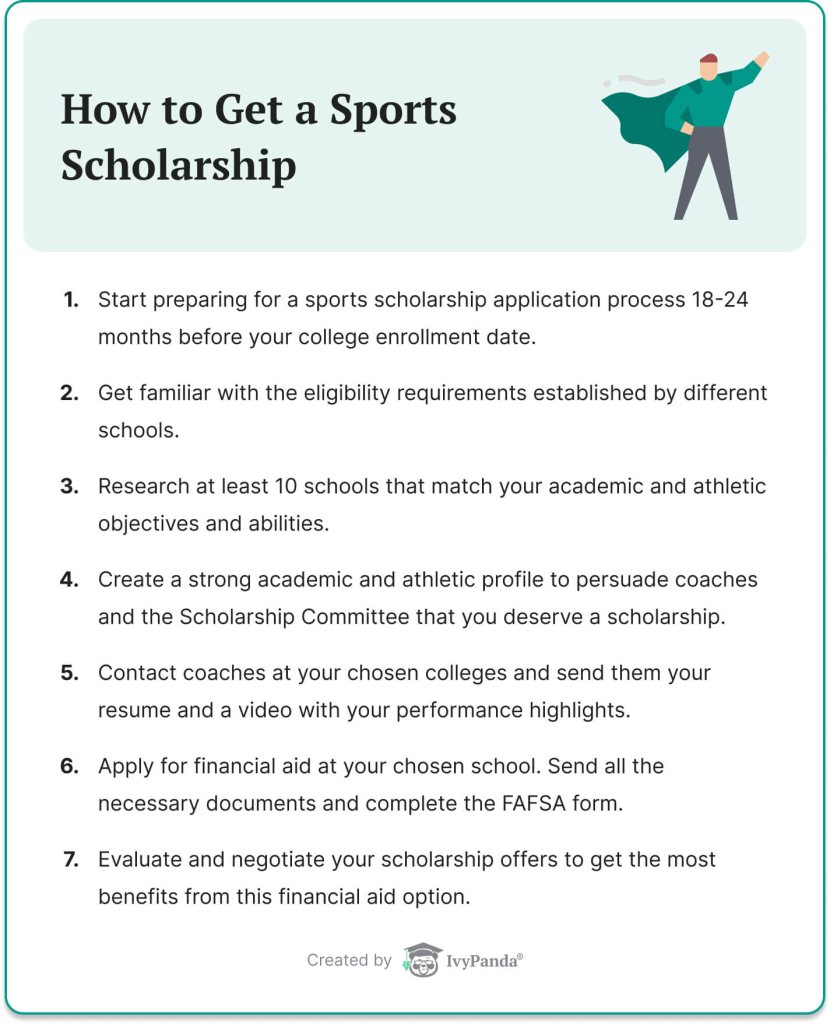Many young people cannot afford college because they come from low-income households. According to Drexel University’s study, 86% of college athletes live below the federal poverty line. However, they can get a sports scholarship or grant if they have remarkable athletic abilities. You might think that only the lucky ones receive such an opportunity. Although athletic scholarships are indeed hard to get, you shouldn’t give up.

Our team has explained how you can get financial support from colleges or external organizations for your athletic abilities. You’ll also find answers to common questions, eligibility requirements, and other financial aid options available to college athletes.
- 💵 What Is a Sports Scholarship?
- 🏐 Sports That Can Get You a Scholarship
- 🤼 Different Types of Sports Scholarships
- ✅ Eligibility Requirements
- 🏆 How to Get a Sports Scholarship
- ❓ Common Questions
- 🌐 Sports Scholarships and Grants Abroad
- 🏅 Tips for Maximizing Your Chances
- ⚖️ How to Balance Sports and School
- ⭐ Success Stories
- 💰 Bonus: Other Financial Aid Options
- 🔗 References
💵 What Is a Sports Scholarship?
Simply put, a sports scholarship is financial aid to student-athletes to cover their school-related costs. It is awarded by educational institutions based on athletes’ performance in their respective sports.
Usually, the scholarship covers tuition, room and board, and other educational expenditures. In return, the athlete must engage in the school’s athletic program and maintain good academic performance. Sports scholarships are highly competitive but worth applying for, and below, we’ll explain why.
Why Are Scholarships Important?
Sports scholarship importance goes beyond providing financial assistance. Some other valuable benefits include the following:
- Opportunity to pursue a passion. Athletes with scholarships can follow their passion for sports while earning a degree.
- Access to better facilities. Financial aid provides access to better equipment and training programs, which can help athletes enhance their performance.
- Exposure to recruiters. Professional recruiters often scout student-athletes with sports scholarships. So, bursaries widen students’ career opportunities.
- Enlarged network. Sports scholarships provide networking opportunities with coaches and other athletes, which can help start a professional sports career.
- Personal development. Bursaries let students hone their leadership skills, time management, and teamwork.
🏐 Sports That Can Get You a Scholarship
Various sports can get you a scholarship. Check them out below!
However, the availability and number of scholarships may vary depending on the college or university and the level of competition.
The general statistics say that only 2% of high school students get an athletic scholarship. However, this data can vary for different sports. Some sports, such as track and field or basketball, have a larger pool of talented athletes competing for scholarships, making it harder for students to get financial aid. Others, like rowing or fencing, are less competitive and easier to get.
Sports scholarship amounts also differ due to many factors, such as popularity, level of competition, and resources available for the sport at the college or university. Men’s sports scholarships that offer the most money include football FBS ($36,070 per award), basketball ($38,246 per award), and ice hockey ($31,756 per award). As for female athletes, the most generous scholarships are in ice hockey ($41,693 per award), gymnastics ($40,172 per award), and basketball ($36,758 per award).
🤼 Different Types of Sports Scholarships
Two types of sports scholarships are available for students: full-ride and partial. Both options are typically one-year agreements, so you will need to reapply every year. Let’s discuss each of them.
Full Ride Scholarships
The full-ride scholarship is also known as a head count scholarship and is only available in six college sports:
- Football.
- Women’s basketball.
- Men’s basketball.
- Women’s gymnastics.
- Volleyball.
- Tennis.
It covers tuition, fees, room and board, and sometimes even textbooks and other expenditures. The full-ride scholarship is given to students who have achieved outstanding results in their sport, such as winning state championships or breaking records. Universities and colleges frequently offer this scholarship to attract talented athletes to their sports programs.
Here are some examples of universities providing full-ride scholarships:
- Southern Methodist University: $48,544.
- Vanderbilt University: $44,645.
- University of Miami: $43,982.
Partial Scholarships
The partial or equivalency scholarship covers only a fraction of the tuition cost, fees, room, and other expenses.
It is offered to students who have shown promise in their sport but may not have attained as high performance as recipients of full-ride scholarships. The scholarship amount depends on the individual athlete’s abilities and the funding available to the educational institution. Recipients of partial sports scholarships should also maintain a high athletic performance throughout their college career to continue obtaining the aid.
Here are examples of educational institutions offering partial scholarships in different sports:
- Golf: Barry University, Ferris State University, Rollins College.
- Skiing: Dartmouth College, University of Vermont, Westminster College.
- Ice hockey: Princeton University, Cornell University, Boston College.
- Lacrosse: Florida Southern College, Rockhurst University, University of Indianapolis.
✅ Eligibility Requirements for Athletic Scholarships
Requirements for getting athletic scholarships may vary. However, here are some common must-haves:
- Athletic performance. Excellent athletic abilities, talents, and sporting achievements come first if you wish to explore scholarship opportunities in your selected sports.
- Academic performance. Students who want to win an athletic scholarship must prove they can cope with the academic curriculum. Each school’s academic requirement differs, but prospective athletes generally must have a minimum 2.3 GPA.
- Letters of recommendation. Some colleges also require letters of recommendation from past trainers and coaches.
As for the age requirements, colleges don’t set an official age limit for student-athletes to award a scholarship. However, they usually give students a one-year grace period after high school graduation. For tennis players, this period is only 6 months, while skiers and hockey players can wait until their 21st birthday. At the end of the grace period, students should either enroll in a college or cease participating in organized competition.
Before applying for an athletic scholarship, one more critical thing to consider is what sports association governs your college. The US has three major governing bodies: the NCAA, NAIA, and NJCAA. Further, we’ll discuss the general requirements of each organization.

NCAA Requirements
The National Collegiate Athletic Association (NCAA) supports intercollegiate athletics across three divisions. Colleges are named Division I, Division II, or Division III institutions based on size, athletic program budget, and ability to award scholarships. Today, the NCAA consists of 1,098 colleges and universities.
Below are NCAA Division I and Division II eligibility guidelines:
- Complete 16 core courses for Division I or Division II, respectively.
- Maintain a core course GPA of at least 2.3 (Division I) or 2.2 (Division II).
- Earn an ACT or SAT score matching your core-course GPA on a respective sliding scale.
- Graduate from high school.
- Receive the final amateurism certification from the NCAA Eligibility Center.
As for Division III schools, they don’t provide athletic scholarships but can offer other financial aid packages.
NAIA Requirements
The National Association of Intercollegiate Athletics (NAIA) governs small college sports programs. It grants athletic scholarships in 28 sports at more than 250 schools across the US.
To qualify for this organization’s scholarship, you must be a high school graduate admitted to an NAIA school and meet at least two of these criteria:
- Score 18 on the ACT or 860 on the SAT.
- Earn at least a 2.0 GPA on a 4.0 scale.
- Graduate in the top 50% of your class.
NJCAA Requirements
The National Junior College Athletic Association (NJCAA) governs athletics in 2-year community colleges. Students seeking sports scholarships but having lower grades may especially benefit from this option.
Here are the NJCAA eligibility criteria:
- You must have a high school diploma or its equivalent, like a GED certificate.
- Non-high school graduates must complete one term of college work and pass 12 credits with a 1.75 GPA or higher.
- You must be a full-time student while playing the chosen sport.
Ways to Extend Eligibility
If you don’t meet all sports scholarship requirements, such as athletic abilities or academic performance, you can take a redshirt year. It allows student-athletes to practice with the team and obtain funding without competing in games.
You can get an academic redshirt if your grades are lower than necessary. However, to do so, you should fit these criteria:
- Earn 16 NCAA-approved core-course credits in the right areas.
- Have a minimum 2.0 core-course GPA.
- Submit your proof of graduation to the Eligibility Center.
Another reason athletes take a redshirt year is when they get injured or experience burnout and need a year to recover.
Besides redshirt, other terms defining a student-athlete’s eligibility status include grayshirt, blueshirt, and greenshirt:
- Redshirt: Athletes can get scholarships and practice with the team. However, they cannot compete for 1 year, and then get another year to complete 4 seasons.
- Blueshirt: Athletes can receive bursaries, which count toward the next year’s scholarship total. They can participate in freshman practice. Yet, they cannot compete for 1 year.
- Greenshirt: Students can obtain scholarships, practice, and play in games, but they enroll in college a semester early.
- Grayshirt: Athletes study their first semester part-time and cannot practice with the team during this period. They also cannot get funding and compete during their part-time semester.
🏆 How to Get a Sports Scholarship
Though getting a sports scholarship takes time and effort, it is worth it. Here are the steps you should take to raise your chances.
1. Start Early
The general recommendation is to begin your preparation approximately 18 to 24 months before the date you plan to attend college. Use this time to work on your athletic abilities and academic performance. You should also research the requirements and eligibility criteria for colleges and universities offering sports scholarships.
2. Understand Eligibility Requirements
Before applying for an athletic scholarship, comprehend the eligibility criteria. They may vary depending on the specific sport and division level. Note that to get a scholarship from an NCAA school, you must create a Certification Account at the NCAA Eligibility Center during your freshman or sophomore year of high school.
3. Research Schools
Many educational institutions offer athletic scholarships. So, you should weigh all your options and find the perfect match for you academically and athletically. Don’t miss out on college tours, meeting with other student-athletes, and contacting the administration in case of questions.
4. Create a Strong Academic and Athletic Profile
You’ll need a compelling portfolio to compete for a scholarship. Maintain good grades throughout high school and take challenging courses to showcase your academic ability. You might also create a sports scholarship video presenting your best performances and skills. Later, you can send it to coaches and recruiters to help them judge your athletic potential.
5. Make Contact with College Coaches
Reach out to coaches directly and express your interest in their programs. Share your sports scholarship video and relevant stats or accomplishments to display your capabilities. Remember to be proactive and ensure that coaches know your passions and skills.
6. Apply for Financial Aid
Prepare all the documents necessary to apply for athletic funding: academic transcript, athletic resume and video, and letters of recommendation. We also advise filling out the FAFSA form. Even if you don’t think you’ll get federal aid, you should still do it because most colleges require students to submit their FAFSA to be considered for financial assistance.
7. Evaluate Scholarship Offers
When you’re getting ready to lock down your offer, you should compare the financial aid packages at each college that has made you an offer. If a program doesn’t have a full-ride athletic scholarship, the school will often try to compensate for the difference with academic, merit-based, or other scholarship types. Don’t underestimate alternative financial aid options when making your final decision.

❓ Athletic Scholarship: Common Questions
Still have questions concerning athletic scholarships? Let’s address the most widespread concerns and dispel the myths surrounding them.
Can You Play Sports in College without a Scholarship?
Absolutely! Numerous colleges let undergraduates engage in sports as walk-ons. It means they can obtain a place on a team and a scholarship based on their accomplishments. Additionally, some schools have club teams or intramural sports that enable students to play without the pressure of being a scholarship athlete.
Can You Get a Sports Scholarship While in College?
While winning a sports scholarship during your college life is possible, it’s uncommon. Scholarships are typically offered to incoming freshmen or transfer students based on their athleticism. Yet, a walk-on athlete who chooses to try out for a college program can earn a scholarship for future seasons.
Do Ivy League Schools Give Athletic Scholarships?
No, they don’t. They provide need-based financial aid only. That’s because Ivy League schools prioritize academic excellence and consider sports part of the educational experience. These institutions require a similar level of academic attainment from athletic and non-athletic students.
How Much Does a Sports Scholarship Cover?
The sports scholarship amount depends on the school, sport, and division level. For instance, NCAA Division I colleges can bestow full scholarships covering tuition, room and board, textbooks, and other expenditures. Division II schools grant partial scholarships that cover a part of these fees.
How Many Scholarships Can You Get?
A student-athlete can acquire a limitless number of scholarships. Apart from sports bursaries, you can apply for grants or academic scholarships. It’s even possible to earn athletic scholarships for more than one sport, although it’s infrequent. However, your total financial aid cannot exceed your cost of attendance.
When Can a School Take Away Your Athletic Scholarship?
Students can lose funding if they break team or school rules, fail academically, or suffer a career-ending injury. We advise scrutinizing the terms and conditions of your scholarship agreement. It should describe when your financial assistance may be revoked.
Do You Have to Pay Back a Scholarship?
Usually, student-athletes don’t have to repay a scholarship. Yet, some scholarships may demand repayment if the recipient fails to meet specific obligations, like maintaining good academic and athletic performance. You should carefully read and comprehend the scholarship agreement to avoid displeasing consequences.
🌐 Sports Scholarships and Grants Abroad
Many colleges and universities globally provide athletic funding to international students. If you’re an athlete eager to study overseas, consider schools in Canada, the United Kingdom, and other nations.
Here are 6 sports scholarships outside the US.
- The Trinity Sports Scholarships at Trinity College Dublin
Trinity College Dublin, situated in Ireland, is a suitable destination for high-performing athletes seeking to practice with experienced coaches and have world-class facilities. Six different scholarships are available to students, from emerging sports talents to Olympic-level athletes. - WLV Sports Scholarship Program at the University of Wolverhampton
The University of Wolverhampton in the UK offers three athlete scholarship packages with different financial awards – Bronze (£500), Silver (£1,000), and Gold (£1,500). - Sports scholarships at Newcastle University
Newcastle is a renowned UK sports city and home of the Newcastle Football Club. Newcastle University has many sports funding options for enrolled students, including disability sports scholarships. - International Sports Scholarship Program at the University of Stirling
This university boasts one of the largest high-performance athletic programs in the UK. The program gives generous financial aid of up to 5,000 pounds annually. - The University of Calgary Award for International Student Athletes
This Canadian university presents scholarships to foreign students playing for the Calgary Dinos team. The award covers up to $10,000 in tuition and fees. To qualify, you should meet the English Language Proficiency requirement and earn at least a 2.0 GPA. - UL Sports Scholarships at the University of Limerick
Sports funding at this university is divided into three tiers: Bronze, Silver, and Gold. Depending on the level, you can expect an award of up to 10,000 euros. It covers training, accommodation, and gym membership.
🏅 Tips for Maximizing Your Chances
Consider these insights from scholarship winners and experts to boost your odds of receiving financial assistance:
- Start early. Begin your search for sports scholarships early, preferably in your sophomore or junior year.
- Make the right coaching connections. Contact college coaches and attend their games to show your interest and dedication.
- Behave proactively. Participate in camps and showcases to get spotted by college coaches and scouts.
- Improve your academics. Good grades and test scores are vital for most sports scholarships, so ensure you are doing well in your classes and taking challenging courses.
- Build your character. Remember that coaches could be watching you on and off the field. Be careful about how you act and demonstrate your attitude.
- Create a profile in an online recruiting service. Post your profile on Next College Student Athlete or SportsRecruits because many college programs use services like these.
- Use social media. Post your best plays and performances to showcase your skills to coaches and enlarge the athletic network.
- Choose the program wisely. Remember that the amount of money isn’t the only thing that matters. Ensure the team, campus, and academics are all a perfect match for you.
- Be realistic. Consider schools that match your academic and athletic abilities rather than only focusing on the most prestigious programs.
- Negotiate offers. The best strategy to get a scholarship is to have more offers. When negotiating with a coach about money, consider how much the college will cost you after the scholarship is deducted.
⚖️ How to Balance Sports and School
Balancing sports and classes can be troublesome for a student-athlete. Check out some tips to understand how to succeed in both areas.
- Create a schedule. Develop a timetable that incorporates time for homework, classes, practice, games, and rest.
- Communicate with professors and coaches. Notify the faculty of your schedule and communicate any conflicts or worries.
- Prioritize your health. Ensure you eat healthy, sleep enough, and care for your body to prevent burnout and injury.
- Set attainable goals. Decide what you wish to achieve in both academics and sports and work towards your objectives consistently.
- Remain motivated. Remember why you cherish your sport and keep pursuing your goals, even when it becomes challenging.
- Have a support system. Surround yourself with supportive friends, relatives, coaches, and teammates who realize the demands of balancing sports and studies.
⭐ Success Stories: Inspiring Athletes Who Earned Scholarships
You might be amazed how many famous athletes started their careers with an athletics scholarship. We gathered three motivating stories and hope that one day, you’ll be the one inspiring young athletes.
Basketball Scholarship: Jimmy Butler
Jimmy Butler is a professional basketball player with a membership in the Miami Heat in the NBA. He’s famous for his defensive skills, work ethic, and leadership on and off the court.
After graduating from Tomball High School, Jimmy Butler entered Tyler Junior College in Texas. There, he was one of the lower-ranked players in his recruitment class. Yet, during his senior year, he averaged 20 points and 8 rebounds per game, enough to win a full sports scholarship.
Soccer Scholarship: Dom Dwyer
Dom Dwyer is a soccer player who represents Orlando City, SC, in Major League Soccer (MLS). His goal-scoring skills and physicality on the field make him remarkable.
Although Dwyer grew up in the UK, he went to the US on a soccer scholarship and played for Tyler College Apaches, where he enjoyed a successful two-year period.
Football Scholarship: Dwayne Johnson
You must have heard of Dwayne’ The Rock’ Johnson. He gained fame in the late 1990s and early 2000s as a wrestler for World Wrestling Entertainment (WWE). Since then, he has transitioned to a thriving career in Hollywood.
Dwayne Johnson initially pursued athletics at the University of Miami, where he obtained a full-ride scholarship in football. Despite his accomplishments in this sport, he later transitioned into professional wrestling. Eventually, he became a household name through his collaboration with the WWE.
💰 Bonus: Other Financial Aid Options for Student Athletes
An athletic scholarship isn’t your sole option to follow your passion and study at college. Here are some alternative types of financial aid to consider.
✅ Academic scholarships
Also known as merit-based aid, academic scholarships are provided to students excelling in their studies. To qualify, one must maintain a high GPA or attain a specific score on standardized tests.
Here are some universities offering merit scholarships:
✅ Private scholarships
Non-governmental companies or individuals can give private scholarships. This aid is typically based on criteria other than learning achievements. Community involvement, leadership skills, artistic or athletic talent, or specific fields of study are just some of the potential requirements.
Examples:
- Cameron Impact Scholarship ($20,000).
- Coca-Cola Scholars Program Scholarship ($20,000).
- Equitable Excellence Scholarship ($2,500, $10,000, or $25,000).
✅ Need-based aid
Need-based aid is tailored for those who can’t afford tuition without outside assistance. Factors like family earnings, assets, and the cost of attendance influence how much money you can get. You should complete the FAFSA form to apply for federal need-based aid.
✅ Grants
Students receive grants based on financial need, academic merit, or their combination. Grants can come from numerous sources. Federal and state governments, private organizations, and educational institutions are the most widespread ones.
Examples:
✅ Loans
Student loans are financial aid that must be repaid with interest. They help students pay for educational costs, such as tuition, books, and living expenses.
Examples:
✅ Work-study jobs
Work-study jobs let students make money to cover education costs. Such jobs are frequently offered by colleges and may be available to applicants with financial need. This employment takes place on or off-campus and involves tasks like working at the library service desk, tutoring, assisting with research projects, or providing administrative support.
We hope our article has addressed most of the concerns about athletic scholarships. If you have friends who could benefit from our advice, share this publication with them!
🔗 References
- Scholarships, Grants, and Bursaries: Sports — UCAS
- 5 Tips for Scoring Athletic Scholarships — Discover
- How to Get Athletic Scholarships — The Princeton Review
- Athletic Scholarships — Education USA
- Eligibility & Compliance — The University of North Carolina at Chapel Hill
- Guide to Playing Sports in College — Bucknell University
- How to Balance Sports and Studies as a Student-Athlete — Azusa Pacific University
- What Are NCAA Divisions? Division 1 vs 2 vs 3 — PrepScholar
- Guide for the College-Bound Student-Athlete 2022-23 — NCAA


![Your First Year of College: How to Prepare & Be Successful [+ Infographic]](https://ivypanda.com/blog/wp-content/uploads/2023/03/shocked-fuuny-young-female-wonk-stares-notebook-carries-pen-has-piles-papers-workplace-wears-spectacles-striped-clothes-309x208.jpg)
